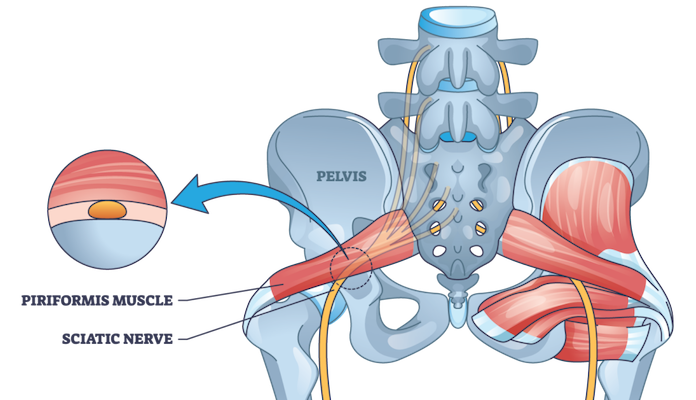
Piriformis Syndrome is a condition that is often misunderstood and misdiagnosed, yet it is a significant source of pain and discomfort for many people. At Precision Pain Care and Rehabilitation, we focus on providing comprehensive and effective treatment options for conditions like Piriformis Syndrome, emphasizing interventional pain management techniques to improve quality of life.
What is Piriformis Syndrome?
Piriformis Syndrome occurs when the piriformis muscle, a small muscle located deep in the buttock, compresses or irritates the sciatic nerve. This irritation can lead to pain, numbness, and tingling sensations radiating down the leg, symptoms similar to those of sciatica. The piriformis muscle plays a key role in hip movement and stabilization. When it becomes tight or inflamed, it can affect the sciatic nerve that runs directly beneath (or in some cases, through) the muscle.
Common Symptoms of Piriformis Syndrome
The hallmark symptoms of Piriformis Syndrome include:
- Buttock Pain: A deep, aching pain in the buttock area, which can worsen with prolonged sitting or physical activity.
- Leg Pain: Pain radiating from the buttock down the back of the leg, similar to sciatic nerve pain.
- Reduced Range of Motion: Difficulty in hip movements such as rotating the leg outward or lifting it.
These symptoms can significantly affect a person's ability to carry out daily activities, impacting their quality of life.
Causes and Risk Factors
Piriformis Syndrome can be caused by a variety of factors, including:
- Muscle Strain: Overuse or injury can cause the piriformis muscle to tighten, leading to nerve compression.
- Anatomical Variations: In some individuals, the sciatic nerve may pass through rather than under the piriformis muscle, increasing the risk of compression.
- Repetitive Activities: Activities that involve repetitive hip movements, such as running or cycling, may increase the likelihood of developing Piriformis Syndrome.
- Prolonged Sitting: Sitting for extended periods can exacerbate the problem, especially if the posture is poor.
Diagnosis of Piriformis Syndrome
Diagnosing Piriformis Syndrome can be challenging, as its symptoms often mimic other conditions such as lumbar radiculopathy (sciatica from a herniated disc). A thorough medical history and physical examination are essential, including specific maneuvers to identify pain triggered by the piriformis muscle. Imaging studies like MRI may be used to rule out other potential causes of sciatic nerve irritation.
Interventional Pain Management for Piriformis Syndrome
At Precision Pain Care and Rehabilitation, interventional pain management offers effective solutions for patients suffering from Piriformis Syndrome. Here are some interventional approaches that can be used to address this condition:
- Injection Therapy
- Piriformis Muscle Injection: A corticosteroid or local anesthetic can be injected directly into the piriformis muscle to reduce inflammation and alleviate pain. This technique can provide both diagnostic insight and therapeutic relief, helping to confirm the piriformis muscle as the source of the pain.
- Botox Injections: In some cases, Botox injections can be used to reduce muscle spasms and tension in the piriformis muscle, providing longer-lasting relief.
- Nerve Blocks
- Sciatic Nerve Block: A nerve block may be used to reduce pain signals from the irritated sciatic nerve. This can provide significant relief for patients experiencing severe radiating pain.
- Physical Therapy and Exercise
- Interventional pain management is often combined with physical therapy to maximize outcomes. Physical therapists at our clinic can guide patients through specific stretches and strengthening exercises to improve flexibility and reduce compression of the sciatic nerve. Techniques such as stretching the piriformis muscle, hip rotators, and lower back can be particularly beneficial.
- Minimally Invasive Procedures
- For patients who do not respond to conservative measures, minimally invasive procedures like radiofrequency ablation may be considered. This technique involves using heat generated by radio waves to temporarily disable the nerve fibers transmitting pain signals, providing longer-lasting relief.
Benefits of Interventional Pain Management
Interventional pain management offers a targeted approach to treating Piriformis Syndrome, which provides several benefits:
- Precision: The treatment directly targets the source of pain, minimizing unnecessary exposure to systemic medications.
- Reduced Recovery Time: Many of these interventions are minimally invasive, allowing patients to return to their normal activities quickly.
- Multidisciplinary Approach: Combining interventions with physical therapy and lifestyle modifications helps address the root cause and prevents recurrence.
Lifestyle Modifications and Self-Care
In addition to interventional treatments, patients can benefit from certain lifestyle changes that can help manage Piriformis Syndrome:
- Stretching and Strengthening: Regular stretching of the piriformis, hamstrings, and hip flexors can help reduce muscle tension. Strengthening exercises targeting the gluteal muscles can improve hip stability.
- Avoid Prolonged Sitting: Taking frequent breaks to stand and move around can prevent the piriformis muscle from becoming tight.
- Proper Posture: Maintaining good posture while sitting and standing can reduce unnecessary stress on the lower back and hips.
Conclusion
Piriformis Syndrome is a painful condition that can significantly impact an individual's quality of life. At Precision Pain Care and Rehabilitation, our focus is on utilizing interventional pain management techniques to offer relief and help patients regain mobility. From injection therapies to physical rehabilitation, our comprehensive approach ensures that each patient receives the care that best suits their specific needs.
If you are experiencing symptoms of Piriformis Syndrome, contact us at Precision Pain Care and Rehabilitation. Our team is here to provide expert guidance and a tailored treatment plan to help you get back to living pain-free.
Precision Pain Care and Rehabilitation has two convenient locations in Richmond Hill – Queens, and New Hyde Park – Long Island. Call the Queens office at (718) 215-1888 or (516) 419-4480 for the Long Island office to arrange an appointment with our Interventional Pain Management Specialists, Dr. Jeffrey Chacko or Dr. Sonny Ahluwalia.















